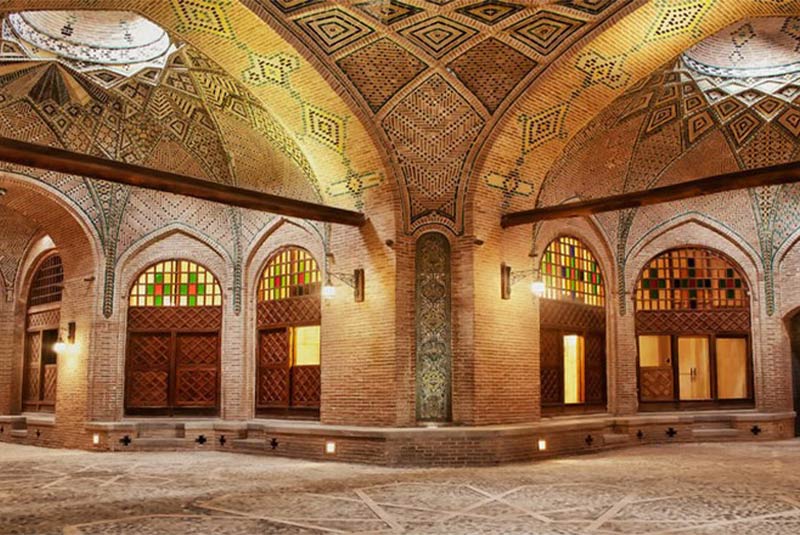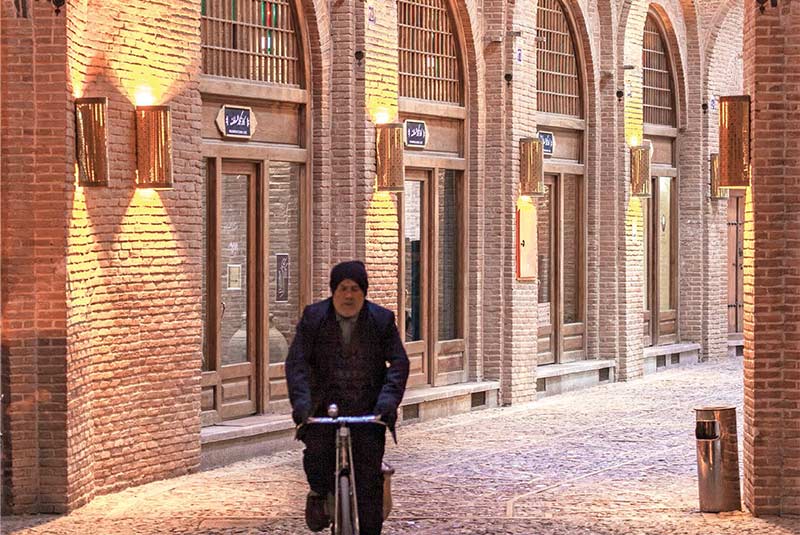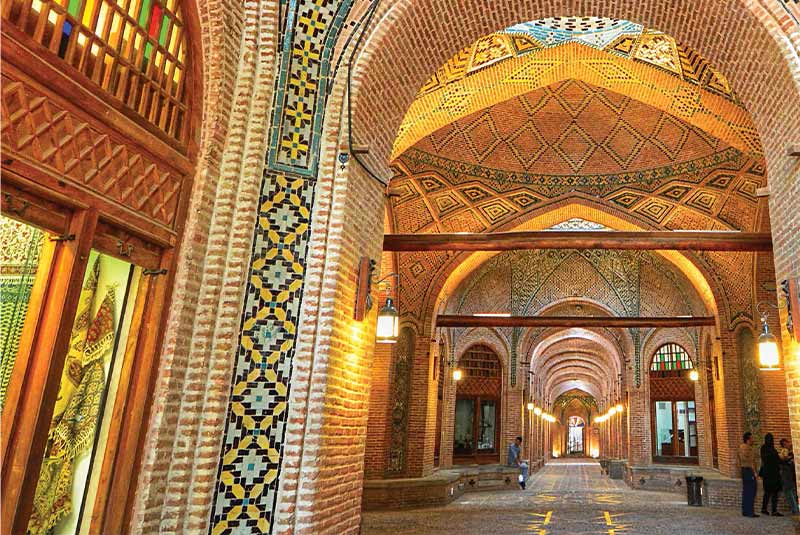The Sa’d al-Saltaneh Caravanserai is located just north of the Qazvin bazaar on Imam Khomeini Street.
This large complex consists of: four commercial courtyards, three administrative complexes, two rows of merchant stalls alongside a magnificent domed hall, one small bazaar, and two bathhouses – all in an area of 16,700 square metres. There is an entrance from Imam Street into the main courtyard of the caravanserai. The condition of this entrance shows how the main entrance hall was lost when the street was widened. There are commercial stalls surround the main courtyard. In the centre, there is a small pool that was likely filled via auxiliary aqueducts. A smaller yard with pillars sits west of the main courtyard, and has several stalls and sleeping areas that were used to store merchandise.
Sa'd al-saltane Carvanserai, an Old Persian Trade Centre

Iran’s political and economic relationships with European and Russian governments expanded greatly during the reign of Naser al-din Shah Qajar (r. 1848–1896 CE). The import and export of various types of merchandise increased the ever-growing wealth of Iranian businessmen and merchants; meanwhile, the city of Qazvin made significant contributions of its own, due its proximity to the capital. Two major Iranian highways converged in Qazvin on their way to Tehran: the road from Azerbaijan to the Ottoman Empire (Turkey), and the other that connected Guilan in northern Iran to Russia by way of the Caspian Sea. Many imported goods came into the country through these major roads and any goods exported from the central cities of Iran to Russia, Iran’s principal trading partner, inevitably passed through Qazvin. In addition, the road from Qazvin to Hamedan provided a valuable route into Iraq. Not only were these roads important for commerce, but also useful for religious reasons. Many caravans on the Hajj and Ziyarat pilgrimages came from central and eastern Iran and passed through Qazvin on their way to Mecca and Iraq.
Qazvin’s significant role in communicating with Russia and Europe led to the construction of a road from Tehran to Qazvin in the year 1880. Baqir Arbab became the overseer of this road after his relative, Amin Sultan, supervised its construction. He earned a great deal from managing the road and, using his newfound influence, became the governor of Qazvin, earning the title of Sa’d al-Saltaneh in 1889. The booming economy in Qazvin, which served as a commercial intermediary for the caravan routes to Tehran, inspired the construction of the grand Caravanserai of Sa’d al-Saltaneh along with the main bazaar in Qazvin. Sa’d al-Saltaneh had already built a large caravanserai with two courtyards near Qazvin’s main guesthouse, much of which still remains in his name and can be found at the beginning of Rahahan Street.
The Architecture of the Sa’d al-Saltaneh Caravanserai Complex
The Sa’d al-Saltaneh Caravanserai is located just north of the Qazvin bazaar on Imam Khomeini Street. This large complex consists of: four commercial courtyards, three administrative complexes, two rows of merchant stalls alongside a magnificent domed hall, one small bazaar, and two bathhouses – all in an area of 16,700 square metres. There is an entrance from Imam Street into the main courtyard of the caravanserai. The condition of this entrance shows how the main entrance hall was lost when the street was widened. There are commercial stalls surround the main courtyard. In the centre, there is a small pool that was likely filled via auxiliary aqueducts. A smaller yard with pillars sits west of the main courtyard, and has several stalls and sleeping areas that were used to store merchandise.
The Sadiye building sits just east of the main court-yard. In the 1910s, the complex was called the Sadiye or Sa’adat Caravanserai. Many believed it was named after the gardens of Sa’adat Abad, the famous gardens of the Safavid period. The caravanserai also has merchant stalls on one of the floors. In addition to connecting to the main courtyard, it also has a separate entrance from the north-eastern corner that opens directly onto the street. East of the complex and behind the stalls, there is a warehouse with many pillars that connects to the courtyard. The three northern courtyards of the complex are connected by corridors along one axis. Following this axis down the corridor eastwards will lead to the warehouse and, to the west, to the Sa’d al-Saltaneh bazaar. In addition to connecting all of these spaces, it also defines the architecture of the northern courtyard. The main courtyard has four terraces connected by corridors, which link it to the other parts of the complex. The principal corridor of the bazaar begins just south of the courtyard and extends to the southern end of the caravanserai, with the Barandaz courtyard (loading station) and Shotorkhan courtyard connecting to it.
The Sa’d al-Saltaneh bazaar is arranged in a very orderly manner; the corridor maintains a fixed width and has stalls on either side. The intersection of the main corridor with the gheysarieh, a domed section of the bazaar dedicated to luxury items, is the most beautiful part of the complex of the Qazvin bazaar. The large charsoogh, which is comprised of one central dome and four surrounding domes, gives the impression of a much larger space. A plaque that can be found under this dome states that the building of the caravanserai was completed in 1895 CE. The gheysarieh has two openings along the length of the charsoogh; the eastern one leads to a storeroom, the western one to the Sa’d al-Saltaneh bazaar. Above this second intersection, a large dome with geometric patterns accentuates the gheysarieh. The southern courtyards of the complex support the bazaar’s commercial functions. They include the Shotorkhan and Barandaz courtyards and washrooms. The Shotorkhan courtyard has a separate gate that leads to the Sa’d al-Saltaneh bazaar. Just south of this, there is a large, spacious area with a hundred pillars that was used as the Barandaz courtyard and for livestock. This courtyard was not carefully designed or constructed, as evidenced by the poor arrangement of the stalls and the lack of terrace. A hammam can be found in the south-eastern cor-ner of the main courtyard. It is a small but a complete bathhouse.

Sa’d al-Saltaneh Bazaar
The Sa’d al-Saltaneh Bazaar begins on Imam Street and organically extends up to Al-Nabi Mosque and surrounds its perimeter. This bazaar was built after everything else on the eastern side of the caravanserai and used to be one of the historic city’s most important passages. To the west of the bazaar, a door opens onto the Tumanyans complex. The main entrance is connected to Imam Street and was, for many years, the trading centre of Tumanyans family business, one of the most successful merchants of the late Qajar and early Pahlavi eras. The architecture of this complex differs from the rest of the caravanserai in that it resembles Pahlavi-era buildings. The Shah (king) Hammam, a.k.a. the Razavi Hammam is to the west of the bazaar and was built before the Sa’d al-Saltaneh Caravanserai. This large bathhouse contains different rooms with pools and saunas as well as other rooms. It was recently discovered that polychrome tiles lined the walls and that the floor was made of marble. It has not yet been proven that the bathhouse is the same as the King’s Hammam mentioned in texts of the Safavid era; regardless, this bathhouse is the oldest building in the Sa’d al-Saltaneh complex.

Until World War I, (1914–1918), the Sa’d al-Saltaneh Caravanserai was one of the most important centres of business and commerce in Qazvin. The bazaar was so busy that there were often two or more merchants selling goods from some stalls. The volume of imported and exported goods was so high that all the storerooms, courtyards, corridors and stalls were filled with merchandise. Until the early 2000s, the caravanserai was primarily under the influence of the carpenter’s guild and mostly offered wood-related products, such as furniture, woodcarvings and paints. During this time, the Iran Cultural Heritage, Handicrafts and Tourism Organization acquired and restored the caravanserai. It was then assigned to the Qazvin municipality in order to continue the restoration process. Nowadays, this renovated complex is primarily a tourist destination, with a diverse range of cafés and shops that sell a variety of items, including traditional decorative items, photography, clothing, etc. Various facilities, both residential and cultural, are still active in amongst the various courtyards, ensuring that these traditional spaces continue to provide a vibrant and memorable experience for visitors.
Article: Gilgamesh Heritage & Tourism Magazine No.7 Autumn 2019, Hidden Gems of Iran
By: Mehrzad Parhizkari (Researcher in Architecture and Urban History)
Translated by: Natalie Morris






Comment
Leave a Comment